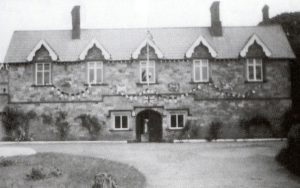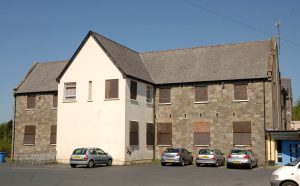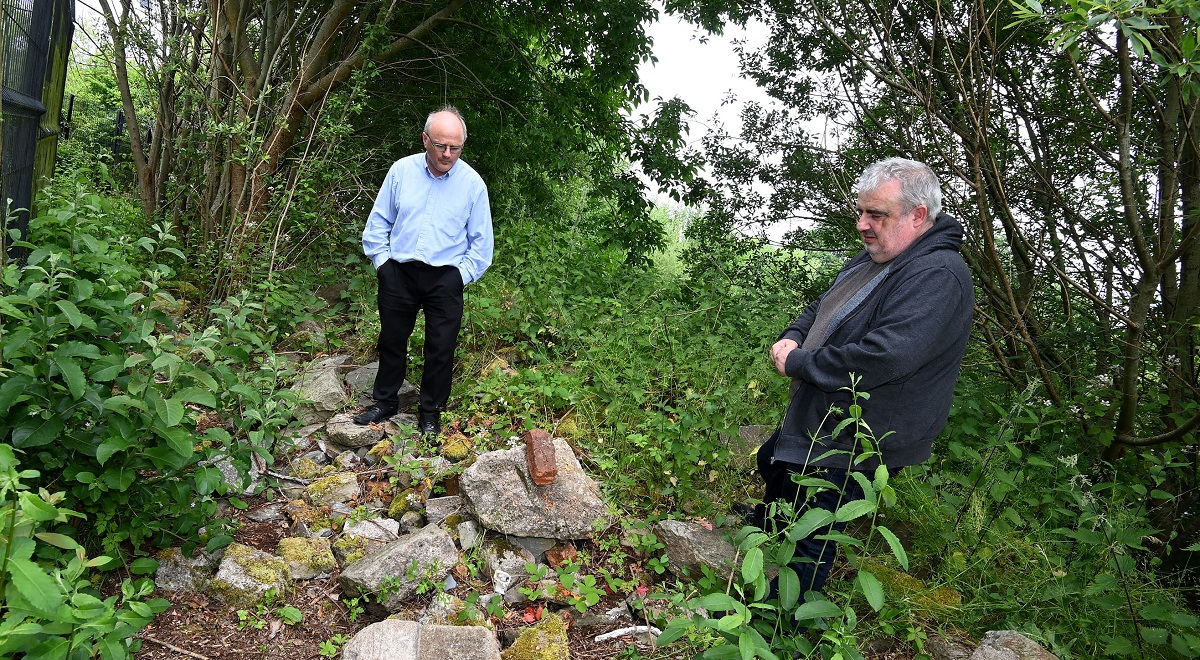Last week, the UH highlighted renewed efforts to commemorate those who were buried in unmarked graves at the site of a former workhouse in Omagh.
Local historians claim that a large number of bodies could still be buried on former workhouse grounds on Woodside Avenue, located close to the former RUC station on Omagh’s Gortin Road.
The initiative to erect a permanent memorial is being led by Sinn Féin’s Barry McElduff and Omagh Heritage Group.
These days, the workhouse is a little-known part of Omagh’s long history.
It has long been reduced to rubble, with the exception of a few stones and faint memories left in the minds of those who wish to keep the legacy alive.
But just what were the workhouses?
We worked with the Omagh Heritage Forum to get an insight into the story behind these historic famine-era houses.
In England 1834, an act was passed that would overhaul the strategy on poverty, and see the desperately poor, described as ‘paupers’, given an opportunity to exchange work for essential food and shelter in ‘workhouses’, through the Poor Law Amendment Act 1834.
This act was a further development on the existing Poor Relief Act 1601, and was implemented by the Prime Minister of the time, Earl Gray, as part of the ‘Whigs’, which were rivals to the Tories.
This change in legislation put in practice changes from the 1832 Royal Commission’s findings, which found the previous system too expensive, and poorly ran.
Two major transformations occurred with the report: Firstly, the eligibility of receiving relief was tightened, meaning that only the most desperate of paupers wished to enter the workhouses.
And secondly, the segregation of classes of paupers, which recommended that those of the same union be placed in the same section, and that married men and women be separated from their spouses.
The Irish Poor Relief Act was then instated four years later in 1838, and saw an initial 130 unions formed, with a further extension of 33 in later years.
The Omagh union was officially formed on May 9, 1839, and covered an area of 272 square miles, and a total population of 66,388 over 29 electoral districts.
Planning for the construction of Workhouses began on May 1, 1839, by architect, George Wilkinson, and by August 24, 1881, the workhouse was declared fit for paupers, with their first admissions that day.
The new site was built on what is now known as Woodside Avenue, near the Grange Park, and it was designed to be a medium-sized workhouse to fit 800 inmates.
The architect, George Wilkinson, designed many of the workhouses across Ireland, using the same H-block patterns.
The Omagh workhouse utilised the H-shape to divide the men and women’s sections straight through the middle.
The complex consisted of a two-storey admissions block which contained a boardroom for the Guardians, Clerks Offices, Porters Quarters, and one night accommodation for travelling workers.
A master’s garden, with the boys’ and girls’ yard separated either side led to the main workhouse, which was three storeys.
The ground floor held the offices for the Masters and Matrons, as well as classrooms for the children.
The second floor held the master’s quarters, with the boys’ and girls’ quarters either side on their respective segment of the workhouse. And on the third floor, the dormitories for the men and women, again on their respective segregated side, were held, with an additional section for the elderly workers.
At the back end of the workhouse complex was the kitchen, which connected the dormitories to the infirmary, ‘idiot ward’ and ‘dead house’.
The kitchen was much more than a place for the inmates to reap the rewards of their labour, but it was also the section that the women worked in.
It consisted of the day room, laundry and wash house, the mill and kitchen itself, as well as serving as a chapel when needed.
This section would be the only place that all members of the house would congregate together, however, speaking to one another was forbidden, especially in cases of marriage, so daily meals were held in silence.
The last building of the original site was the dead house, which sought to provide those who died in the workhouse with coffins and a grave in the mass burial site to the left of the complex.
This mass grave, however, would be used heavily in later years to come.

Titled, the ‘Workhouse’, we still haven’t touched on what work went on in these yards. For the owners of the houses, the aim was to either be self-sufficient, or to make profit (though the running costs of the workhouses made profit-making practically impossible).
This was done through using the inmates as labour to export produce, such as stone breaking, firewood cutting, weaving and bone-crushing for a while, until an inquiry into the Andover workhouse scandal in England emerged, where the government found out starving inmates were sucking bone marrow from the bones.
Life in the workhouse was grim, and the conditions the inmates were kept in were, by our standards now, uninhabitable.
However, life in the workhouses was set to become much worse.
From 1845 to 1852, the great famine ravaged its way across Ireland; turning the workhouses into a sought-after haven for the masses that were reduced to survival desperation.
In the first few years of the Omagh Workhouse’s operation, a few hundred inmates slowly joined the ranks, but by the time the famine hit, a mass influx of admissions saw the complex expand beyond its capacity.
And in 1847, a scheme was put in place to expand the capacity to 1,000; an extra 200 inmates from what the original design was intended to hold.
Two hundred extra galleries to hold these new inmates were installed, however the workhouse actually held 1,100, due to the high demand, which then brought its own set of problems.
The inflation of the population saw mass overcrowding in these undignified, mouldy dormitories, and infection spread like wildfire. Cholera, Typhoid and Dysentery broke out all in all sections of the workhouse, and such was the state of emergency, that the infirmary took over the complex, and the able- bodied inmates were moved out of Omagh entirely.
At the same time, the guardians that oversaw the operations of the workhouse had to leave, and the weekly meetings were held at the courthouse.
This crisis saw architect. George Wilkinson. back to design and implement the fever hospital to prevent such catastrophes from occurring again.
The crisis settled around 1865, and the workhouse returned to normal operations until the end of the First World War in 1918, where the British military took over two of the wards in the infirmary in Omagh, putting strain on the medical officer amid the also growing influenza pandemic, and forced him to move uninfected inmates into the infectious fever ward.

By the 1920s, the partition of Ireland saw the start of the end for the workhouses, as the Southern Unions sought the abolishment of the Board of Guardians, who oversaw the operations of the workhouses.
And by 1925, the workhouses began to close in the newly-formed Republic of Ireland.
Though workhouses remained open in Northern Ireland, one important meeting foresaw the future for the Omagh site.
The item for the agenda of that meeting was the closure of the workhouse to allow for the Tyrone General Hospital.
However, at the time, the proposal saw the majority defeated, and the workhouse remained, for now.
Operations continued in the workhouse complex for another 26 years, until the decision was finally made to close the most of the workhouse, and develop an 11-bed maternity wing to the fever hospital and infirmary. This medical centre was put to public use under the name of the ‘Omagh General Hospital’.
The admission block used by the former Guardians became occupied by the Omagh Rural District Council until 1958, when, for the first time, the bustling house of labour, fell quiet as no persons occupied the block.
The rural council would be the last to occupy the historic site, as the block would then be demolished in 1962 to make way for the PSV Testing grounds.
Five years after the demolishment of the admissions block, the rest of the workhouse came down, brick-by-brick.
The dormitories, offices, and all remaining workhouse structures (excluding the infirmary and fever hospital) were taken apart to make way for the new government training centre in 1968.
The last remaining section still in use after 165 years was the then general infirmary, and later-built fever ward, which ceased its usage in June of 1998, after the new Sperrin County Hospital was built.
It was knocked down in 2006, and so ended the brutal legacy of the workhouse in the town.
Practically no remnants of the workhouse or general hospital are left, bar a few stones, that, to the untrained eye, would even hint at what was once there.
If not for the Omagh Heritage Group, this little known gem of history would be lost to time, as much of Omagh’s history has done.
With recent pushes across Tyrone and Fermanagh to recognise those who suffered extreme hardships in undignified conditions, there has been a drive to recognise the Omagh site, which local historians believe still holds 2,000 bodies of those who worked, and passed though, there.
Following similar moves in Enniskillen and Dungannon, Fermanagh and Omagh District Council is currently investigating what measures can be done to formally commemorate those who lived and died at the site.







